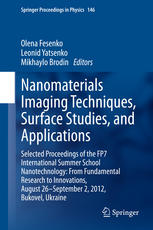

Most ebook files are in PDF format, so you can easily read them using various software such as Foxit Reader or directly on the Google Chrome browser.
Some ebook files are released by publishers in other formats such as .awz, .mobi, .epub, .fb2, etc. You may need to install specific software to read these formats on mobile/PC, such as Calibre.
Please read the tutorial at this link: https://ebookbell.com/faq
We offer FREE conversion to the popular formats you request; however, this may take some time. Therefore, right after payment, please email us, and we will try to provide the service as quickly as possible.
For some exceptional file formats or broken links (if any), please refrain from opening any disputes. Instead, email us first, and we will try to assist within a maximum of 6 hours.
EbookBell Team

4.4
92 reviewsThis book presents cutting-edge research on a wide range of nanotechnology techniques and applications. It features contributions from scientists who participated in the International Summer School “Nanotechnology: From Fundamental Research to Innovations” in Bukovel, Ukraine on August 26 – September 2, 2012 funded by the European Commission FP7 project Nanotwinning implemented by the Institute of Physics of National Academy of Sciences of Ukraine and partner institutions: University of Tartu (Estonia), European Profiles A.E. (Greece), University of Turin (Italy) and Université Pierre et Marie Curie (France). Worldwide experts present the latest results on such key topics as microscopy of nanostructures; nanocomposites; nanostructured interfaces and surfaces; nanooptics; nanoplasmonics; and enhanced vibrational spectroscopy. Imaging technique coverage ranges from atomic force microscopy and spectroscopy, multiphoton imagery, and laser diagnostics of nanomaterials and nanostructures, to resonance Raman and SERS for surface characterization, and scanning tunneling microscopy of organic molecules. The breadth of topics highlights the exciting variety of research currently being undertaken in this field and suggests new opportunities for interdisciplinary collaboration and future research.